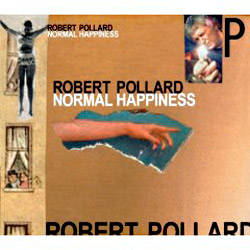Robert PollardNormal Happiness(Merge)
While his previous opus, From a Compound Eye, could be Robert Pollard’s “homage” to early 1970s snappy power-pop and crunchy, playfully lubricious glitter-rock, Normal Happiness might well be his “progressive rock” album. But not the “prog” of hammy soloing and “lofty” Philosophy 101/Tolkien lyrical content—rather, as defined by Led Zeppelin circa Houses of the Holy/Physical Graffiti, the poppier side of Todd Rundgren’s Utopia, and Love’s moody psych-pop classic Forever Changes. At times, the shade of the latter is palpable—Pollard’s singing sometimes evokes the doleful, volatile croon of recently deceased Love leader Arthur Lee. Further, both gents have a fondness for merrily caustic lyrics; “I come down/Pushed around/Oh Lord, shower me lonely/Piss on me love/Now I’m alone,” goes Pollard’s “Towers and Landslides.” The music (performed almost entirely by Pollard and Todd Tobias) is a tersely tuneful, slightly staccato, layered, orchestrated mélange of guitars, keyboards, and background voices, making nearly every song seem like a mini-epic. Those favoring the artier side of RP’s personae will go mega-batty for this. MARK KERESMAN
The Album LeafInto the Blue Again(Sub Pop)
It takes a true virtuoso to make a handful of chord changes sound like a complex musical arrangement. In fall fashion, the aesthetic is artfully achieved with layers of clothing. In the Album Leaf’s case, it is layers of piano, organ, strings, and gently galloping beats. Jimmy LaValle (Tristeza, the Locust, Black Heart Procession) has been playing music since he was 4 years old and writing, recording, and performing as the Album Leaf since 1999. Into the Blue Again, his latest collection of galactic folk rock, widens the breadth of what Album Leaf fans have come to expect, without any risky attempts to redefine itself. Songs still build simply, a repetitious assembly of descending chords that slowly evolve into triumphant refrain.
Unfortunately, album opener “The Light” is less a booming kickoff than a shanked punt—a ginger keyboard melody slowly emerges from a swelling synth wave before spiraling off into a spacey mist of modulation. The rest of the record holds together a little better. Songs like “See in You” and “Into the Sea” follow the standard (yet satisfying) Album Leaf formula as guitar and organ melodies slowly revolve around each other before building to a crescendo against a rhythm section made up of either electronic crackles or live drums or both. But while previous albums were composed mainly of instrumentals and borderline minimalist electronica, Into the Blue Again shows LaValle coming out of his lyrical shell. Tracks that feature his modest vocal talents, like “Always for You,” “Writing on the Wall,” and “Wherever I Go,” are structured more like conventional pop songs, with a more defined verse, chorus, and bridge. Still, these songs fit comfortably in LaValle’s canon of work. Into the Blue Again is the Album Leaf doing what it does best, sonically progressing without straying too far from form. GEOFF JOHNSTON
The Nice BoysThe Nice Boys(Birdman)
Like leaving The Hardy Boys behind for the comfort of A Clockwork Orange and pot, “Teenage Nights” allows Portland’s Nice Boys a late-bloomers’ rite of passage; ditching the teen-beat punk of former bands the Riffs and Exploding Hearts for a hazier, glam take on power-pop—the ’70s experienced vicariously through Mick Rock photographs. Theirs is a story not without its darker passages. In July 2003, three members of Exploding Hearts were killed in a van accident on a late-night drive from San Francisco. They’re survived by Nice Boys frontman Terry Six. Goofy odes to girls and guitars still abound, with the “oohs” holding a few extra syllables this time. “Johnny Guitar,” smoother than the guitar hero of its title, pulses along with the nerdy disaffection of Joey Ramone asking “Do You Wanna Dance?” on End of the Century. “Only in Dreams” coos its way to elegy, both for youth and the imminent future. “Avenue 29” opens with a rainy-day serenade (“The sun don’t shine on my street today/ Getting lost in twilight and shades of gray,” Six sings metaphorically) before shuffling unexpectedly into sweet skiffle for the surrealist couplet, “Say hello to the next in line/To lose their minds.” For T. Rex acolytes, they’re charmingly lacking in seductive technique (ELO is more like it). Maybe that’s why they’re nice boys. Take them home to Mom, but hide the joint. KATE SILVER
The ByrdsThere Is a Season(Columbia/Legacy)
The Byrds were the first American group to meet the mid-1960s British Invasion head-on, on its own terms. (Not to offend Beach Boys devotees, but pre–Pet Sounds Boys were stylistically far removed from the Beatles, Byrds, Stones, etc.) The Byrds—featuring Roger McGuinn’s distinctively chiming electric 12-string guitar—not only thrived but managed to pull off one of the coolest tricks ever, influencing those who’d originally inspired them: Bob Dylan and the Beatles. Subsequently, the Byrds had an impact on generations of bands, from the obscure and not-so-obscure groups on the three Nuggets box sets to REM, Hüsker Dü, Teenage Fanclub, and Wilco. The Byrds’ takeoff was a concurrence of Dylan’s poetic, timely lyrics and the Fab Four’s danceable electricity. While not “inventors” of folk rock, they put it on the map commercially and expanded upon it. After laying the foundation for psychedelia (the singular hit “Eight Miles High,” a fusion of throbbing rock, Indian raga, and free jazz, as astonishing now as then), the Byrds were among the first to blend country music with rock (the album Sweetheart of the Rodeo, featuring future alt-country icon Gram Parsons). On the precipice of disbanding, all the tributaries, including electronic music and Brill Building pop, coalesced for the original lineup’s swan song, The Notorious Byrd Brothers. After 1968, their heyday (commercially, anyway) for the most part behind them, the lineup, featuring virtuoso guitarist Clarence White, made much excellent music (“Chestnut Mare,” the searing psych-country “King Apathy III”) before their 1973 dissolution. The four-disc Season presents a beautifully exhaustive account of the Byrds, one of the first bands to truly matter and one of the few continuing to matter. MARK KERESMAN




